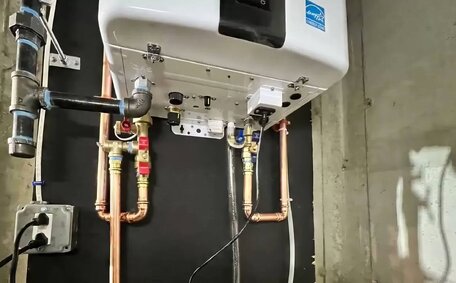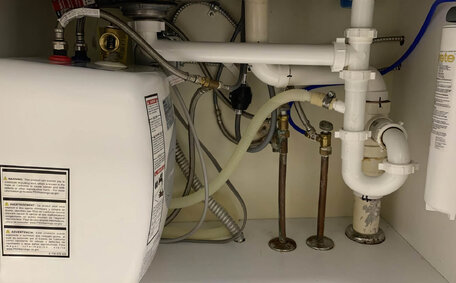What is a Water Booster Pump System?
A water booster pump system enhances an existing plumbing network by amplifying water pressure, ensuring efficient distribution within residential and commercial settings. It elevates the kinetic energy from the main water supply, converting it into higher pressure.
This pressurised water is then supplied to fixtures throughout the building.
Water booster pumps counteract insufficient water supply pressure, which may impair the functionality of taps, showers, fire sprinklers, and irrigation systems, ensuring an adequate water flow.
The booster pump intensifies incoming water pressure, enhancing flow rates and resolving problems associated with low water pressure.
Booster pumps are manufactured in different models, including single-stage centrifugal pumps, the simplest and most widespread type, which can deliver pressures up to 8 bar. Conversely, multi-stage pumps, with several impellers, are more apt for large structures needing substantial pressure increments. The versatility is further enhanced by variable-speed drives (VSD), which modulate pressure to meet fluctuating demands efficiently.
Selecting and installing the correct booster pump requires evaluating the building’s pressure and flow rate needs, influenced by its size, number of floors, and fixture count. Specialist assessment ensures optimal performance through the right pump choice and installation.
Why You May Need a Water Booster Pump
There are several common situations where installing a water booster pump can be beneficial for residential or commercial buildings in Stp>When water pressure falls below 350 kPa, issues such as poor tap flow, ineffective appliances, and slow cistern refills emerge, especially in upper levels of multi-storey buildings. Booster pumps elevate pressure, delivering consistent water supply across all floors.
Addressing Inadequate Flow Rate
In situations of satisfactory pressure but low flow impacting multiple fixtures, booster pumps ingeniously ensure ample flow to meet varied demands in larger homes or commercial buildings.
Irrigation Systems
Gardening, including nurturing lawns and greens, often demands pressure levels more intense than what municipal water supplies can generate. Integrating a pressure booster into the irrigation system ensures adequate pressure and volume to optimise the use of water for sprinklers.
Boosting Fire Protection Systems
A strategically placed booster pump can assist in magnifying the pressure head and pumps increase water flow rates necessary for fire sprinkler systems. This is crucial for fire safety.
Correctly sizing and configuring a booster pump to your property’s specific needs can effectively resolve low pressure issues and enhance water distribution for crucial applications.
Signs You Need a Booster Pump
There are several telltale signs that indicate your home or commercial building could benefit from installing a booster pump system:
Improving Low Water Flow from Faucets
If water trickles out weakly or sputters from faucets, inadequate supply pressure could be the issue. Boosting pressure can increase flow to normal levels.
Reducing Wait Times for Hot Water
It may take a long time for hot water to reach distant faucets due to low pressure. A booster pump provides the extra push to get hot water there faster.
Upgrading Shower Pressure
Frustrating showers with uneven flow or inadequate spray force are a sign of low supply pressure. The right booster system can rejuvenate shower performance by optimising the pressure flow rate.
Fixing Slow-Filling Toilets
Toilets depend on adequate pressure to fill their tanks and flush effectively. Boosted pressure corrects slow filling issues.
Consult a plumbing professional if you conclude 'I need booster assistance’ for these symptoms when installing water fixtures. After evaluating your water supply and fixtures, they can advise the optimal booster pump solution for your needs.
There are several telltale signs that indicate your home or commercial building could benefit from installing a booster pump system:
If water trickles out weakly or sputters from faucets, inadequate supply pressure could be the issue.
How Booster Pumps Work
Booster pumps, should you need pump operation, work by drawing water from the mve this augmentation. Enclosed within the pump is an impeller - a rotating element with blades that whirl rapidly when activated, illustrating booster pump how does it propel water with such force. Water e, the impeller blades’ rapid spin applies centrifugal force, propelling water to the housing’s perimeter. This conversion of kinetic to pressure energy facilitates the movement of water through the pump.
This acceleration increases the water pressure to levels suitable for efficient distribution.
The pressure level is adjusted to meet specific requirements before the water exits through the discharge pipe. The degree of pressure increase depends on the pump size, motor speed, and impeller configuration, resulting in the regulated flow needed within the plumbing network.
Variable speed drive (VSD) pumps are capable of supplying the right motor speed automatically as needed when responding to pressure demand shifts. Multi-stage pumps, often used in applications requiring high pressures, use successive impellers to reach those levels, allowing for smooth flow water dynamics. Overall, booster pumps are key in boosting water pressure and hydraulically amplifying the existing supply to overcome low pressure issues.
Types of Booster Pumps
Overview of Single Stage Centrifugal Pumps
Single-stage booster pumps are among the various models offered, and these are the most common among them. They use a rotating impeller to generate pressure in one stage. Flow rates up to 450 litres per minute and pressures up to 8 bar can be achieved depending on pump size.
Understanding Multi-Stage Centrifugal Pumps
For very high-pressure applications or instances where a duty pump does require robust action, multi-stage units with two or more impeller stages in series are employed to create pressure exceeding 8 bar. Each impeller stage progressively works to increase pressure.
Exploring Submersible Pumps
For properties with water storage tanks where the water needs to circulate, Submersible boosters, ideal for those who need water to be efficiently circulated from a submerged position, can significantly escalate outlet pressure. Flow rates around 240 litres/minute are typical.
Examining Positive Displacement Pumps
Do I require intricate mechanics? These reciprocating pumps use an oscillating diaphragm or rotating gears/lobes that move pressure water in a pulsating flow pattern. They can achieve high pressures up to 17 bar but have limited flow capacity.
The Role of Variable Speed Drives
Speed control technologies such as speed drive vsd permit adjustments in the pump motor speed to align with the varying pressure demand. This optimises energy efficiency and can prevent excessive pressure buildup.
Choosing the Right Booster Pump
Choosing the optimal booster pump for your needs depends on several key factors:
Water Source and Flow Rate
Consider whether the water source is mains supply or from a well/rainwater tank. Higher flow rates are needed for large homes/buildings. Check supply pipe diameter as undersized pipes will limit flow.
Pressure Requirement
Determine the pressure needed on the top floor or at the furthest point to ensure adequate flow to all areas. Consider pressure demands of appliances like showers and irrigation systems.
Pump Type
When enhancing domestic water applications, single-stage centrifugal units are the go-to choice for their simplicity and efficacy.
Multi-stage pumps are specifically designed to achieve exceptionally high pressures, making them suitable for demanding applications that require both significant pressure and flow rate.
Pump Controls
Variable speed drives optimise energy efficiency by matching pump output to demand. Pressure sensors turn the pump on/off as needed, seamlessly integrating into your maintenance schedule.
Engage in a dialogue with a professional to select the appropriate water pump, with the right capacity and features that fit seamlessly with your building’s water systems.
Choosing the optimal booster pump for your needs depends on several key factors:
Consider whether the water source is mains supply or from a well/rainwater tank.
Determine the pressure needed on the top floor or at the furthest point to ensure adequate flow to all areas.
Booster Pump Installation
Installation of a booster pump demands professional expertise to ensure optimal performance and longevity, underscoring the importance of engaging qualified plumbers for the task.n help - it can be external or internal in a plant space or cupboard area with sufficient ventilation, drainage and electral that the booster pump is aligned precisely with the water flow direction for efficient operation. Gate valves on the inlet and outlet are recommended for maintenance.
The plumber will also install accessories like pressure gaug pressure boost reliably for years to come.
Integrating with Existing Plumbing
When installing a booster pump system, it is important to properly integrate it with the existing plumbing in a building. This ensures the system complements rather than disrupts the normal water supply.
A key consideration is to install the booster pump on the main water supply line after all pre-treatment devices such as filters and softeners. This allows the pump to boost pressure to the entire plumbing system. The pump should have isolation valves on inlet and outlet to facilitate maintenance.
Selecting the correct pipe diameter is essential for connecting the pump to the plumbing network. Incorrect pipe sizing can either restrict flow or cause pressure fluctuations. It is vital that the connected pipes match the main system’s dimensions to preserve flow rates.
Installation of pressure-reducing valves on branches leading to sensitive fixtures mitigates the risk of water hammer, a phenomenon that can damage pipes. Incorporating an expansion tank and surge arrestors can absorb shock waves, and fitting flow restrictors can avert excessive water discharge in fixtures.
For expansive buildings, the strategic use of multiple smaller pumps rather than a single large unit ensures redundancy and enhances the system’s reliability.
Intelligent integration and correct installation of booster pumps within the existing plumbing framework assure uninterrupted operation and steadfast reliability. Seeking guidance from qualified plumbers is recommended to assess and fulfill system requirements.
When installing a booster pump system, it is important to properly integrate it with the existing plumbing in a building.
Permits and Code Compliance
Installing a pressure booster pump system in Strathfield requires obtaining the necessary permits and adhering to plumbing codes and regulations. This ensures the system is legally compliant and does not pose any risks due to excessive water pressure.
A licensed plumber should oversee permit applications to guarantee compliance with official standards. Approvals from Sydney Water and Strathfield Council are essential, as is adherence to Australian standards for plumbing and pressure vessels.
The AS/NZS 3500 code stipulates a maximum pressure increase of 500 kPa for pumps in plumbing systems. It’s crucial to fit pressure limiting valves to prevent pressures from surpassing 55he water pressure boost your building requires.
Permits offer the benefit of impartial review, and adherence to codes confirms adherence to industry best practices. Consulting with established plumbing prThey ensure robust water flow for everyday use and reinforce vital fire prevention systems.
In locales like Strathfield, a baseline water pressure of 240 kPa is needed for effective operation of taps and showers. For optimal performance, especially in high-rise buildings, pressures may need to approach 345 kPa (50 psi).
In scenarios where water pressure falls short, especially for fire sprinkler systems, Booster systems are often employed, and a break tank might be introduced to secure the water required for effective functioning. To find out more about the detailed minimum pressures for sprinkler systems, you can reference specifications outlined in AS2118.1 regulations, which vary based on hazard categories.
Similarly, even water distribution in irrigation across lawns, gardens, and playing fields depends on proper pressurisation, aided by pressure boosters that achieve the 172-310 kPa (25-45 psi) typically required for uniform sprinkler operation.
By regularly inspecting your booster pump system and using a water pressure booster pump when water pressure drops, you can keep your building’s water supply well-regulated. This maintains safe and comfortable water supply plus enables critical fire and irrigation systems.
Monitoring with SCADA Systems
Integrating booster pumps with SCADA monitoring facilitates intelligent control, optimises efficiency, and supports proactive maintenance by gathering real-time performance data through sensors and other devices.
This allows remote monitoring of factors like pressures, flow rates, run times, power usage, and temperature. The SCADA system can trend data over time to identify issues before they become problems. Some SCADA platforms even utilise AI technologies to diagnose problems and predict maintenance needs.
Through SCADA pump monitoring, large residential and commercial premises can ensure their booster pumps operate efficiently. Data-driven insights facilitate proactive maintenance, ensuring consistent water pressure.






